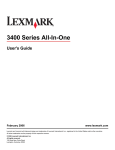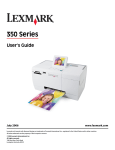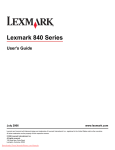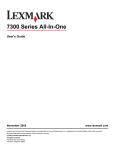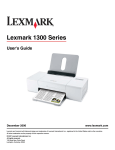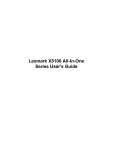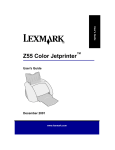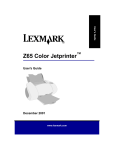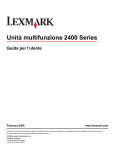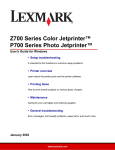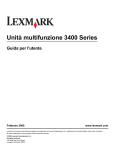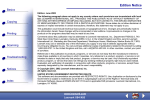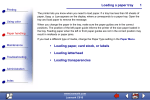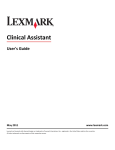Download 2400 Series All-In-One User`s Guide
Transcript
2400 Series All-In-One User's Guide February 2006 www.lexmark.com Lexmark and Lexmark with diamond design are trademarks of Lexmark International, Inc., registered in the United States and/or other countries. All other trademarks are the property of their respective owners. © 2006 Lexmark International, Inc. All rights reserved. 740 West New Circle Road Lexington, Kentucky 40550 Edition notice February 2006 The following paragraph does not apply to any country where such provisions are inconsistent with local law: LEXMARK INTERNATIONAL, INC., PROVIDES THIS PUBLICATION “AS IS” WITHOUT WARRANTY OF ANY KIND, EITHER EXPRESS OR IMPLIED, INCLUDING, BUT NOT LIMITED TO, THE IMPLIED WARRANTIES OF MERCHANTABILITY OR FITNESS FOR A PARTICULAR PURPOSE. Some states do not allow disclaimer of express or implied warranties in certain transactions; therefore, this statement may not apply to you. This publication could include technical inaccuracies or typographical errors. Changes are periodically made to the information herein; these changes will be incorporated in later editions. Improvements or changes in the products or the programs described may be made at any time. Comments about this publication may be addressed to Lexmark International, Inc., Department F95/032-2, 740 West New Circle Road, Lexington, Kentucky 40550, U.S.A. In the United Kingdom and Eire, send to Lexmark International Ltd., Marketing and Services Department, Westhorpe House, Westhorpe, Marlow Bucks SL7 3RQ. Lexmark may use or distribute any of the information you supply in any way it believes appropriate without incurring any obligation to you. To obtain additional copies of publications related to this product, visit the Lexmark Web site at www.lexmark.com. References in this publication to products, programs, or services do not imply that the manufacturer intends to make these available in all countries in which it operates. Any reference to a product, program, or service is not intended to state or imply that only that product, program, or service may be used. Any functionally equivalent product, program, or service that does not infringe any existing intellectual property right may be used instead. Evaluation and verification of operation in conjunction with other products, programs, or services, except those expressly designated by the manufacturer, are the user’s responsibility. © 2006 Lexmark International, Inc. All rights reserved. UNITED STATES GOVERNMENT RIGHTS This software and any accompanying documentation provided under this agreement are commercial computer software and documentation developed exclusively at private expense. Safety information Use only the power supply and power supply cord provided with this product or the manufacturer's authorized replacement power supply and power supply cord. Connect the power supply cord to an electrical outlet that is near the product and easily accessible. Refer service or repairs, other than those described in the user documentation, to a professional service person. CAUTION: Do not set up this product or make any electrical or cabling connections, such as the power supply cord or telephone, during a lightning storm. Contents Finding information about the printer..........................................................................7 Setting up the printer.....................................................................................................9 Checking the box contents..................................................................................................................9 Learning about the printer..........................................................................................10 Understanding the parts of the printer...............................................................................................10 Using the control panel......................................................................................................................11 Learning about the software.......................................................................................12 Using the printer software..................................................................................................................12 Using the Imaging Studio..................................................................................................................12 Using the All-In-One Center..............................................................................................................13 Opening the All-In-One Center...................................................................................................................13 Using the Scanning & Copying tab.............................................................................................................13 Using the Saved Images tab.......................................................................................................................14 Using the Maintain/Troubleshoot link..........................................................................................................15 Using the Solution Center..................................................................................................................15 Using Print Properties........................................................................................................................17 Opening Print Properties.............................................................................................................................17 Using the Save Settings menu....................................................................................................................17 Using the I Want To menu..........................................................................................................................17 Using the Options menu.............................................................................................................................17 Using the Print Properties tabs...................................................................................................................18 Using the Photo Editor.......................................................................................................................18 Using the Web Toolbar......................................................................................................................19 Loading paper and original documents.....................................................................21 Loading paper....................................................................................................................................21 Loading various paper types.............................................................................................................21 Loading original documents on the scanner glass............................................................................24 Printing.........................................................................................................................26 Changing the paper type...................................................................................................................26 Printing a document...........................................................................................................................26 Printing a Web page..........................................................................................................................26 Printing photos or images from a Web page.....................................................................................27 Printing cards.....................................................................................................................................28 3 Printing envelopes.............................................................................................................................28 Printing transparencies......................................................................................................................28 Printing collated copies......................................................................................................................29 Printing the last page first (reverse page order)................................................................................29 Working with photos...................................................................................................30 Printing photos...................................................................................................................................30 Printing photos stored on the computer......................................................................................................30 Using a PictBridge-enabled digital camera to control printing photos.........................................................31 Customizing photos...........................................................................................................................31 Creating and printing a scrapbook or album page......................................................................................31 Adding text captions to a photo page..........................................................................................................32 Copying.........................................................................................................................33 Making a copy...................................................................................................................................33 Copying 4x6 photos...........................................................................................................................33 Customizing copy settings.................................................................................................................33 Scanning.......................................................................................................................35 Scanning a document........................................................................................................................35 Customizing scan settings.................................................................................................................35 Saving a scanned image...................................................................................................................36 Scanning documents or images for e-mailing...................................................................................37 Scanning text for editing....................................................................................................................37 Scanning images for editing..............................................................................................................37 Scanning clear images from magazines or newspapers...................................................................38 Faxing...........................................................................................................................39 Sending a fax using the software......................................................................................................39 Receiving a fax using the software....................................................................................................40 Networking the printer.................................................................................................41 Shared printing..................................................................................................................................41 Maintaining the printer................................................................................................42 Changing a print cartridge.................................................................................................................42 Removing a used print cartridge.................................................................................................................42 Installing a print cartridge............................................................................................................................42 Achieving better print quality.............................................................................................................44 Improving print quality.................................................................................................................................44 Aligning the print cartridge using the computer...........................................................................................44 Cleaning the print cartridge nozzles............................................................................................................44 Wiping the print cartridge nozzles and contacts.........................................................................................45 4 Preserving the print cartridge............................................................................................................46 Cleaning the scanner glass...............................................................................................................46 Ordering supplies..............................................................................................................................46 Using genuine Lexmark print cartridges............................................................................................46 Refilling a print cartridge....................................................................................................................47 Recycling Lexmark products.............................................................................................................47 Troubleshooting...........................................................................................................48 Setup troubleshooting........................................................................................................................48 Power button is not lit..................................................................................................................................48 Software does not install.............................................................................................................................48 Page does not print.....................................................................................................................................49 Cannot print from digital camera using PictBridge......................................................................................51 Print troubleshooting..........................................................................................................................51 Improving print quality.................................................................................................................................51 Poor text and graphic quality......................................................................................................................52 Poor quality at the edges of the page.........................................................................................................53 Printer does not print or respond................................................................................................................53 Print speed is slow......................................................................................................................................53 Partial document or photo prints.................................................................................................................54 Copy troubleshooting.........................................................................................................................54 Copier does not respond.............................................................................................................................54 Scanner unit does not close........................................................................................................................54 Poor copy quality........................................................................................................................................54 Partial document or photo copies...............................................................................................................55 Scan troubleshooting.........................................................................................................................55 Scanner does not respond..........................................................................................................................55 Scanning takes too long or freezes the computer.......................................................................................56 Scan was not successful.............................................................................................................................56 Poor scanned image quality........................................................................................................................57 Partial document or photo scans................................................................................................................57 Cannot scan to an application.....................................................................................................................57 Fax troubleshooting...........................................................................................................................57 Tips for faxing using the Imaging Studio.....................................................................................................58 Cannot send or receive a fax......................................................................................................................58 Cannot print a fax or received fax has poor print quality.............................................................................58 Received fax is blank..................................................................................................................................58 Jams and misfeeds troubleshooting..................................................................................................59 Paper jam in the printer...............................................................................................................................59 Paper jam in the paper support...................................................................................................................59 Paper or specialty media misfeeds.............................................................................................................59 5 Printer does not feed paper, envelopes, or specialty media.......................................................................60 Banner paper jams......................................................................................................................................60 Error messages.................................................................................................................................60 Removing and reinstalling the software............................................................................................61 Notices..........................................................................................................................62 Index..............................................................................................................................68 6 Finding information about the printer Setup Sheet Description Where to find The Setup Sheet gives you instructions for setting up hardware and software. You can find this document in the printer box or on the Lexmark Web site. User's Guide Description Where to find The User's Guide gives you instructions for using the printer You can find this document on the Lexmark Web site. and other information such as: When you install the printer software, the User's Guide will be installed. • Maintenance 1 Click StartPrograms or All • Troubleshooting • Safety ProgramsLexmark 2400 Series. 2 Click User's Guide. CD Description Where to find The CD contains drivers, software, and publication files. You can find this CD in the printer box. See the Setup The CD installs the Help system on your computer if your Sheet for installation instructions. printer connects to a computer. Help Description Where to find The Help gives you instructions for using the software if your printer connects to a computer. While in any Lexmark software program, click Help, Tips Help, or Help Help Topics. Lexmark Solution Center Description Where to find The Lexmark Solution Center software is included on To access the Lexmark Solution Center: your CD if your printer connects to a computer. It installs 1 Click StartPrograms or All ProgramsLexmark with the other software. 2400 Series. 2 Select Lexmark Solution Center. Readme file Description Where to find This file contains late-breaking information about the printer and software that does not appear in other documentation, as well as information specific to your operating system. To access the Readme file: 1 Click StartPrograms or All ProgramsLexmark 2400 Series. 2 Select Readme. 7 Web site Description Where to find Our Web site contains a variety of information. Visit our Web site at www.lexmark.com. Note: All paths for the Web site are subject to change. 1 Go to the Web site. 2 Select a country or region from the drop-down list in the upper-left corner of the page. 3 Select the link for the information you need. Record the following information (located on the store receipt and the back of the printer), and have it ready when you contact us so that we may serve you faster: • • • • Machine Type number Serial number Date purchased Store where purchased 8 Setting up the printer Checking the box contents Name Description 1 Color print cartridge Cartridge to be installed in the printer 2 Power supply cord Attaches to the power supply port located at the back of the printer 3 Installation software CD 4 Getting Started or Setup Solutions Additional information depending on your country or region 5 Setup Sheet Instructions on setting up printer hardware and software, and information on setup troubleshooting • Installation software for the printer • Help • User's Guide in electronic format 9 Learning about the printer Understanding the parts of the printer 1 6 5 7 4 3 2 Use the To 1 Paper support Load paper. 2 Control panel Operate the printer. 3 PictBridge port Connect a PictBridge-enabled digital camera to the printer. 4 Paper exit tray Stack paper as it exits. 5 Top cover Access the scanner glass. 6 Paper guide Align paper when feeding. 7 Scanner glass Scan, copy, or remove an item. 3 1 2 4 5 Use the To 1 Scanner support Hold up the scanner unit. 2 Print cartridge carrier Install or replace a print cartridge. 10 Use the To 3 Scanner unit Raise to access the print cartridge carrier. 4 Power supply port Connect the printer to a power source. 5 USB port Connect the printer to a computer using a USB cable. Using the control panel Press To 1 Make a color copy. 2 Make a 4 x 6 in. or 10 x 15 cm borderless, color copy of a photo. 3 • Open the All-In-One Center and preview the scan on the computer screen. • Print an alignment page if the button is held down for three seconds. Note: To complete the scan back alignment process, follow the instructions on the computer screen. 4 • • • • Turn the printer on and off. Cancel a copy, scan, or print job. Reset the printer. Feed or eject paper. Note: If the power light blinks, see “Error messages” on page 60. 11 Learning about the software Using the printer software Use this software To The Imaging Studio Open the software component necessary for you to complete a task. The All-In-One Center Scan, copy, print, or fax. The Solution Center Find troubleshooting, maintenance, and cartridge ordering information. Print Properties Select the best print settings for the document you are printing. The Photo Editor Edit photos and graphics. Fast Pics Print photos or images. Web Toolbar Create printer-friendly versions of Web pages. Using the Imaging Studio The Imaging Studio buttons link to software and information that help you with the following tasks: • • • • • • • Printing, browsing, or sharing photos Using photos stored on your computer Scanning and editing text using OCR Scanning, copying, or faxing Finding our Web site Finding tips on using the software Finding maintenance and troubleshooting information To open the Imaging Studio, use one of these methods: Method 1 Method 2 From the desktop, double-click the Imaging Studio icon. 1 Click StartPrograms or All ProgramsLexmark 2400 Series. 2 Select Imaging Studio. Click the Imaging Studio button for the task you want to complete. Click To Details Browse and print photos • View photos saved on the computer. • Print common photo sizes from saved images on the computer. Share photos • Scan and e-mail images or photos. • Find and e-mail images or photos which are stored on the computer. 12 Click To Details Scan and edit text (OCR) Use Optical Character Recognition (OCR) to scan a document to a word processor so you can edit the text. Scan • Scan a photo or document. • Choose scan settings. Copy • Copy photos or documents. • Enlarge, reduce, or change other features before printing. Fax • Scan and send a fax. • Receive a fax. • View fax settings and fax history. Access the Web Visit our Web site. Learn more about what you can do with this software. Find maintenance and troubleshooting information and tools to keep the printer working properly. Using the All-In-One Center Opening the All-In-One Center Use the All-In-One Center software to scan, copy, and fax documents. To open the All-In-One Center, use one of these methods: Method 1 Press Method 2 . 1 Click StartPrograms or All ProgramsLexmark 2400 Series. 2 Select All-In-One Center. Using the Scanning & Copying tab From here Scan You can • Select a program to send a scanned image to. • Select what type of image is being scanned. • Select the scan quality. Note: Click See More Scan Settings to view all settings. 13 From here You can Copy • • • • • • Select the quantity and color of copies. Select a quality setting for copies. Select a blank paper size. Select the size of the original document. Lighten or darken copies. Enlarge or reduce copies. Note: Click Display Advanced Copy Settings to view all settings. Creative Tasks • Print – Repeat an image several times on one page. – Enlarge or reduce an image. – Print an image as a multiple-page poster. • Share – E-mail an image. – Fax using your computer modem. • Save – Save an image on your computer. – MagiChop—Save multiple photos. • Edit – Edit text found in a scanned document (OCR). – Modify an image with a photo editor. Preview • Select a region of the previewed image to scan or copy. • View an image of what will be printed or copied. Note: For more information about the Scanning & Copying tab, click Help in the top center of the screen. Using the Saved Images tab Use the Saved Images tab to perform tasks with images that are saved on the computer. From here Preview You can • Show or create folders. • Preview and select images. • Rename, delete, or edit selected images. Open With Select where to send the saved images. Photo Prints Click Next to print selected photos in Fast Pics. 14 From here Creative Tasks You can • Print – Print an album page with various photo sizes. – Enlarge or reduce an image. – Print an image as a multiple-page poster. • Share – E-mail an image. – Fax using your computer modem. • Edit – Edit text found in a scanned document (OCR). – Modify an image with a photo editor. Note: For more information about the Saved Images tab, click Help in the top center of the screen. Using the Maintain/Troubleshoot link The Maintain/Troubleshoot link provides you with direct links to the Solution Center. 1 Click StartPrograms or All ProgramsLexmark 2400 Series. 2 Select All-In-One Center. 3 Click Maintain/Troubleshoot. 4 Select from these topics: • Maintain or fix quality problems • Troubleshoot problems • Device status and ink level • More printing ideas and how to's • Contact information • Advanced • View the software version and copyright information Using the Solution Center The Solution Center provides help, as well as information about the printer status and ink level. To open the Solution Center, use one of these methods: Method 1 Method 2 From the desktop, double-click the Imaging Studio icon, and then click the Maintain/Troubleshoot button. 1 Click StartPrograms or All ProgramsLexmark 2400 Series. 2 Select Solution Center. 15 The Solution Center consists of six tabs: From this tab Printer Status (Main dialog) You can • View the status of the printer. For example, while printing, the status of the printer is Busy Printing. • View the ink level of the print cartridge. How To Learn how to: • • • • Print, scan, copy, and fax. Find and change settings. Use basic features. Print projects such as banners, photos, envelopes, cards, iron-on transfers, and transparencies. • Find the electronic guide for more information. Troubleshooting • Learn tips about the current status. • Solve printer problems. Maintenance • Install a print cartridge. Note: Wait until scanning is complete before installing a new print cartridge. • • • • • Contact Information Advanced View shopping options for a new cartridge. Print a test page. Clean to fix horizontal streaks. Align to fix blurry edges. Troubleshoot other ink problems. Learn how to contact us by telephone or on the World Wide Web. • • • • • Change the appearance of the Printing Status window. Turn printing voice notification on or off. Change network printing settings. Share information with us regarding how you use the printer. Obtain software version information. Note: For more information, click Help in the lower right corner of the screen. 16 Using Print Properties Opening Print Properties Print Properties is the software that controls the printing function when the printer is connected to a computer. You can change the settings in Print Properties based on the type of project you want to create. You can open Print Properties from almost any program: 1 With a document open, click File Print. 2 From the Print dialog, click Properties, Preferences, Options, or Setup. Using the Save Settings menu From the “Save Settings” menu, you can name and save the current Print Properties settings for future use. You can save up to five custom settings. Using the I Want To menu The “I Want To” menu contains a variety of task wizards (printing a photo, an envelope, a banner, a poster, or printing on both sides of the paper) to help you select the correct print settings for a project. Using the Options menu Use the “Options” menu to make changes to the Quality Options, Layout Options, and Printing Status Options settings. For more information on these settings, open the tab dialog from the menu, and then click the Help button on the dialog. The “Options” menu also provides direct links to different parts of the Solution Center as well as software version information. 17 Using the Print Properties tabs All of the print settings are on the three main tabs of the Print Properties software: Quality/Copies, Paper Setup, and Print Layout. Tab Options Quality/Copies • Select a Quality/Speed setting. • Select a Paper Type. • Customize how the printer prints several copies of a single print job: collated or normal. • Choose Automatic Image Sharpening. • Choose to have the last page printed first. Paper Setup • Specify the size of paper loaded. • Select the orientation of the document on the printed page: portrait or landscape. Print Layout • Select the layout you want to print. • Choose to print on both sides of the paper, and select a duplexing preference. Note: For more information about these settings, right-click a setting on the screen, and then select What's This? Using the Photo Editor Use the Photo Editor software to edit graphics or photos. 1 Click StartPrograms or All ProgramsLexmark 2400 Series. 2 Select Photo Editor. 3 Click File Open to select the image you want to edit. 4 Edit the image with the available tools. Notes: • You can edit only one image at a time. • Move the mouse pointer over the tool for a description. • To undo or redo changes, click the corresponding arrow next to Undo in the top center of the screen. You can reverse multiple changes. 5 Click File Save as. 6 Enter a file name and file type, and then click Save. From this section Quick Fixes You can • • • • • • Remove the red-eye effect caused by light reflection. Fix the photo with one click. Colorize the image using antiquing or sepia tones. Crop the image. Rotate the image. Flip the image. 18 From this section You can Image Adjust • • • • • • • • • Adjust the color depth. Adjust the color balance. Colorize the image. Adjust the Brightness/Contrast. Adjust the blur. Adjust the sharpness. Despeckle (blur) the image to remove dust and scratches. Adjust the exposure. Balance color groupings. Image Size • Change the units of measurement. • Resize the image. • Crop the image. Drawing Tools • Select an area by dragging a box around it. Use this for text box placement and cutting and copying areas. • • • • • • • Add text. Fill pixels with color. Draw with a pencil tool. Draw with a line tool. Erase areas. Paint areas with a paintbrush tool. Pick up a color using the eyedropper. Using the Web Toolbar The Lexmark Web Toolbar lets you create printer-friendly Web pages. Note: The Lexmark Web Toolbar launches automatically when you browse the Web using Microsoft Windows Internet Explorer version 5.5 or later. Click To • Select Page Setup options. • Select Options to customize the toolbar appearance or select a different setting for printing photos. • Access links to the Lexmark Web site. • Access Help for additional information. • Uninstall the Web Toolbar. 19 Click To Normal Print an entire Web page in normal quality. Quick Print an entire Web page in draft quality. Text Only Print only the text of a Web page. Photo Print only the photos or images on a Web page. Note: The number of photos or images valid for printing appears next to Photos. Preview Preview a Web page before printing. 20 Loading paper and original documents Loading paper 1 Make sure: • You use paper designed for inkjet printers. • If you are using photo, glossy, or heavyweight matte paper, you load it with the glossy or printable side facing you. (If you are not sure which side is the printable side, see the instructions that came with the paper.) • The paper is not used or damaged. • If you are using specialty paper, you follow the instructions that came with it. • You do not force paper into the printer. 2 Before loading paper the first time, squeeze and slide the paper guide to the left side of the paper support. 3 Load the paper vertically against the right side of the paper support. 1 2 4 Adjust the paper guide until it rests against the left edge of the paper. Note: To avoid paper jams, make sure the paper does not buckle when you adjust the paper guide. Loading various paper types Load up to Make sure 100 sheets of plain paper • The paper is designed for use with inkjet printers. • The paper is loaded against the right side of the paper support. • The paper guide rests against the left edge of the paper. 100 sheets of heavyweight matte paper 25 sheets of photo paper 25 sheets of glossy paper • The glossy or printable side of the paper faces you. (If you are not sure which side is the printable side, see the instructions that came with the paper.) • The paper is loaded against the right side of the paper support. • The paper guide rests against the left edge of the paper. Note: Photos require more drying time. Remove each photo as it exits, and allow it to dry to avoid ink smudging. 21 Load up to 10 iron-on transfers Make sure • You follow the loading instructions that came with the iron-on transfers. • The print side of the transfers faces you. • The transfers are loaded against the right side of the paper support. • The paper guide rests against the left edge of the transfers. Note: For best results, load transfers one at a time. 25 greeting cards 25 index cards 25 photo cards • The print side of the cards faces you. • The cards are loaded against the right side of the paper support. • The paper guide rests against the left edge of the cards. 25 postcards Note: Photo cards require more drying time. Remove each photo card as it exits, and allow it to dry to avoid ink smudging. 10 envelopes • • • • • The print side of the envelopes faces you. The stamp location is in the upper left corner. The envelopes are designed for use with inkjet printers. The envelopes are loaded against the right side of the paper support. The paper guide rests against the left edge of the envelopes. Warning: Do not use envelopes that have metal clasps, string ties, or metal folding bars. Notes: – Do not load envelopes with holes, perforations, cutouts, or deep embossing. – Do not use envelopes that have exposed flap adhesive. – Envelopes require more drying time. Remove each envelope as it exits, and allow it to dry to avoid ink smudging. 22 Load up to 25 sheets of labels Make sure • The print side of the labels faces you. • The top of the labels feeds into the printer first. • The adhesive on the labels does not extend to within 1 mm of the edge of the label. • You use full label sheets. Partial sheets (with areas exposed by missing labels) may cause labels to peel off during printing, resulting in a paper jam. • The labels are loaded against the right side of the paper support. • The paper guide rests against the left edge of the labels. Note: Labels require more drying time. Remove each sheet of labels as it exits, and allow it to dry to avoid ink smudging. 50 transparencies • The rough side of the transparencies faces you. • If the transparencies have a removable strip, each strip faces away from you and down toward the printer. • The transparencies are loaded against the right side of the paper support. • The paper guide rests against the left edge of the transparencies. Notes: • Transparencies with paper backing sheets are not recommended. • Transparencies require more drying time. Remove each transparency as it exits, and allow it to dry to avoid ink smudging. 100 sheets of custom-size paper • The print side of the paper faces you. • The paper size fits within these dimensions: Width: – 76–216 mm – 3.0–8.5 inches Length: – 127–432 mm – 5.0–17.0 inches • The paper is loaded against the right side of the paper support. • The paper guide rests against the left edge of the paper. 23 Load up to Make sure 20 sheets of banner paper • You remove all the paper from the paper support before loading the banner paper. • • • • • • You tear off only the number of pages needed to print the banner. You place the required stack of banner paper on the top cover. The leading edge of the banner paper feeds into the printer first. The paper is loaded against the right side of the paper support. The paper guide rests against the left edge of the paper. You have selected the correct paper size for the banner in Print Properties. For more information, see “Using Print Properties” on page 17. Loading original documents on the scanner glass You can copy, scan, and print photos, text documents, magazine articles, newspapers, and other publications. You can also scan a document for faxing. 1 Make sure the printer is on. 2 Open the top cover. 24 3 Place the original document facedown on the scanner glass in the lower right corner. 4 Close the top cover to avoid dark edges on the scanned image. 25 Printing Note: To print photos, see “Working with photos” on page 30. Changing the paper type If you print using specialty paper, such as photo paper, cards, envelopes, transparencies, or iron-on transfers, you need to change the paper type setting from the Print dialog box. 1 Load paper. 2 With a document open, click File Print. 3 From the Print dialog, click Properties, Preferences, Options, or Setup. 4 From the Paper Type section, select the paper type that matches the type of paper you are loading. 5 Click OK. 6 Click OK or Print. Printing a document 1 Load paper. 2 With a document open, click File Print. 3 Click Properties, Preferences, Options, or Setup. 4 Adjust the settings. 5 Click OK. 6 Click OK or Print. Printing a Web page You can use the Lexmark Web Toolbar to create a printer-friendly version of any Web page. 1 Load paper. 2 Open a Web page using Microsoft Internet Explorer 5.5 or later. 3 If you want to check or change your print settings: a From the toolbar area, click Lexmark Page Setup. b Adjust the print settings. c Click OK. Note: For additional print setting options, see “Using Print Properties” on page 17. 26 4 If you want to view the Web page before printing: a Click Preview. b Use the toolbar options to scroll between pages, zoom in or out, or select whether to print text and images or text only. c Click: • Print or • Close, and continue to step 5. 5 From the Lexmark Web Toolbar, select a print option: • Normal • Quick • Text Only Printing photos or images from a Web page 1 Load paper. For best results, use photo or heavyweight matte paper, with the glossy or printable side facing you. (If you are not sure which side is the printable side, see the instructions that came with the paper.) 2 Open a Web page with Microsoft Internet Explorer 5.5 or later. On the Lexmark Web Toolbar, the number of photos valid for printing appears next to Photos. 3 If no number appears next to Photos: a From the Lexmark logo drop-down menu, select Options. b Select the Advanced tab. c Select a lower minimum photo size. d Click OK. The number of photos valid for printing appears next to Photos. 4 Click Photos. The Fast Pics dialog appears. 5 If you want to print all the photos or images using the same settings, select the size you want, the blank paper size in the printer, and the number of copies. 6 If you want to print one photo or image at a time: a Click the photos or images you do not want to print to deselect them. b To make common editing changes: 1 Right click the photo or image. 2 Click Edit. 3 Make your selections. 4 Follow the instructions on the screen. 5 When you are finished making changes, click Done. 6 Select the size you want, the blank paper size in the printer, and the number of copies. 7 Click Print Now. 27 Printing cards 1 Load greeting cards, index cards, or postcards. 2 From the software application, click File Print. 3 Click Properties, Preferences, Options, or Setup. 4 Select a Quality/Speed setting. Select Photo for photos and greeting cards and Normal for other types of cards. 5 Select the Paper Setup tab. 6 Select Paper. 7 From the Paper Size list, select a card size. 8 Click OK. 9 Click OK or Print. Notes: • To avoid paper jams, do not force the cards into the printer. • To prevent smudging, remove each card as it exits, and let it dry before stacking. Printing envelopes 1 Load envelopes. 2 From the software application, click File Print. 3 Click Properties, Preferences, Options, or Setup. 4 From the “I Want To” menu, select Print on an envelope. 5 From the Envelope Size list, select the envelope size loaded. 6 Select Portrait or Landscape orientation. Notes: • Most envelopes use landscape orientation. • Make sure the same orientation is also selected in the software application. 7 Click OK. 8 Click OK. 9 Click OK or Print. Printing transparencies 1 Load transparencies. 2 With a document open, click File Print. 3 Click OK or Print. 28 Note: To prevent smudging, remove each transparency as it exits, and let it dry before stacking. Transparencies may require up to 15 minutes to dry. Printing collated copies If you print multiple copies of a document, you can choose to print each copy as a set (collated) or to print the copies as groups of pages (not collated). Collated Not collated 1 Load paper. 2 With a document open, click File Print. 3 Click Properties, Preferences, Options, or Setup. 4 From the Quality/Copies tab, select the number of copies to print. 5 Select the Collate Copies check box. 6 If you want to print with reverse page order, select the Print Last Page First check box. 7 Click OK. 8 Click OK or Print. Printing the last page first (reverse page order) 1 Load paper. 2 With a document open, click File Print. 3 Click Properties, Preferences, Options, or Setup. 4 From the Quality/Copies tab, select Print Last Page First. 5 Click OK. 6 Click OK or Print. 29 Working with photos Printing photos Note: To print photos or images from a Web page, see “Printing photos or images from a Web page” on page 27. Printing photos stored on the computer 1 Load photo paper. 2 From the desktop, double-click the Imaging Studio icon. 3 Click Browse & Print Photos. 4 Click Show Folders. 5 Select the folder where the photos are stored. 6 Click Hide Folders. 7 Select the photos you want to print by clicking each photo. 8 In the “Photo Prints...” area, click Next to view common photo setting selections. 9 Select a photo size. 10 Select a paper size. 11 Select the number of copies you want. 12 If you want to preview your photos, click Preview. 13 If you want to make common editing changes to your photos: a Click Edit. b Make your selections. c Follow the instructions on the screen. Note: For more advanced photo-editing options, see “Using the Photo Editor” on page 18. 14 Click Print Now. 30 Using a PictBridge-enabled digital camera to control printing photos Connect a PictBridge-enabled digital camera to the printer, and use the buttons on the camera to select and print photos. 1 Insert one end of the USB cable into the camera. Note: Use only the USB cable that came with the digital camera. 2 Insert the other end of the cable into the PictBridge port on the front of the printer. Note: Make sure the PictBridge-enabled digital camera is set to the correct USB mode. For more information, see the camera documentation. 3 Follow the instructions in the camera documentation to select and print photos. Note: If the printer is turned off while the camera is connected, you must disconnect and reconnect the camera. Customizing photos Note: For advanced photo-editing options, see “Using the Photo Editor” on page 18. Creating and printing a scrapbook or album page 1 Load paper. 2 From the desktop, double-click the Imaging Studio icon. 3 Click Browse & Print Photos. 4 Click Show Folders. 5 Select the folder where the photos are stored. 6 Click Hide Folders. 7 From the Creative Tasks area, click Print an album page with various photo sizes. 8 Select a paper size. 9 Select a page layout. For more options: a Click Change the category of layouts listed above. b Select a layout category. 31 c Click OK. d Select a page layout. 10 Drag the photos onto the page. Note: Right-click the photo on the page for editing options. 11 Click Print Now. Note: To prevent smudging, remove each page as it exits, and let it dry before stacking. Adding text captions to a photo page 1 Load paper. 2 From the desktop, double-click the Imaging Studio icon. 3 Click Browse & Print Photos. 4 Click Show Folders. 5 Select the folder where the photos are stored. 6 Click Hide Folders. 7 From the Creative Tasks area, click Print an album page with various photo sizes. 8 Select a paper size. 9 Select a page layout containing a black box. For more options: a b c d Click Change the category of layouts listed above. Select a layout category. Click OK. Select a page layout containing a black box. 10 Drag the photos onto the page. Note: Right-click the photo on the page for editing options. 11 Click inside the white box. A dialog appears. 12 Enter the text you want. 13 Click OK. 14 Click Print Now. Note: To prevent smudging, remove each page as it exits, and let it dry before stacking. 32 Copying Making a copy 1 Load paper. 2 Load an original document facedown on the scanner glass. 3 Press . Copying 4x6 photos 1 Place the 4x6 photo facedown on the scanner glass. 2 Load 4x6 photo paper. 3 Press . Customizing copy settings 1 From the desktop, double-click the Imaging Studio icon. 2 Click Copy. 3 Make your copy settings changes. • Select the quantity and color of copies. • Select a quality setting for copies. • Select a blank paper size. • Select the size of the original document. • Lighten or darken copies. • Select Reduce/Enlarge or Fit to page. 4 If you want to make additional selections: a Click Display Advanced Copy Settings. b Customize the copy settings. c Click OK. 5 Click Copy Now. Advanced Copy Settings tabs Options Print Scan • • • • Select the paper size. • • • • Select the color depth. Select the paper type. Select borderless printing options. Select the print quality. Select the scan resolution. Select whether to auto-crop the scanned image. Select an exact size to be scanned. 33 Advanced Copy Settings tabs Options Image Enhancements Image Patterns • • • • Select whether to deskew the image. Select whether to sharpen blurry edges. Adjust brightness of the image. Adjust the color correction curve (gamma) of the image. • Remove image patterns from magazines or newspapers (descreen). • Reduce more or less of the background noise (scratches) on the color document. 34 Scanning Scanning a document 1 Make sure the printer is connected to a computer, and both the printer and the computer are on. 2 Load an original document facedown on the scanner glass. 3 Press . 4 If you want to scan only a portion of the document, click and drag the dotted line box to select a specific area of the preview image to scan. 5 From the “Send scanned image to:” menu, select a program. 6 Click Scan Now. Customizing scan settings 1 Make sure the printer is connected to a computer, and both the printer and the computer are on. 2 Load an original document facedown on the scanner glass. 3 Press . 4 If you want to scan only a portion of the document, click and drag the dotted line box to select a specific area of the preview image to scan. 5 From the “Send scanned image to:” menu, select a program. 6 Click See More Scan Settings. 7 Select what is being scanned. 8 Select a scan quality. 35 9 If you want to make additional selections: a Click Display Advanced Scan Settings. b Customize the scan settings. c Click OK. 10 Click Scan Now. Advanced Scan Settings tabs Options Scan Image Enhancements Image Patterns • • • • • • • • • Select the color depth. • • • • Straighten images after scan (deskew). Select the scan resolution. Select Optical Scan settings. Select an auto-crop setting. Select an exact area to be scanned. Choose to convert the scanned item to text for editing. Choose to scan multiple images before output. Update the list of programs to send scans. Update the default fax driver. Select whether to sharpen blurry edges. Adjust brightness of the image. Adjust the color correction curve (gamma) of the image. • Remove image patterns from magazines or newspapers (descreen). • Reduce more or less of the background noise (scratches) on the color document. Note: For more information, click Help at the bottom of the screen. Saving a scanned image 1 Make sure the printer is connected to a computer, and both the printer and the computer are on. 2 Load an original document facedown on the scanner glass. 3 Press . 4 If you want to scan only a portion of the document, click and drag the dotted line box to select a specific area of the preview image to scan. 5 From the “Send scanned image to:” menu, select a program. 6 Adjust the settings as needed. 7 Click Scan Now. 8 From the software application, click File Save As. 9 Enter the file name, format, and location where you want the scanned image saved. 10 Click Save. 36 Scanning documents or images for e-mailing 1 Make sure the printer is connected to a computer, and both the printer and the computer are on. 2 Load an original document facedown on the scanner glass. 3 Press . 4 If you want to send only a portion of the document, click and drag the dotted line box to select a specific area of the preview image to scan. 5 From the “Send scanned image to:” menu, select E-mail. 6 Adjust the settings as needed. 7 Click Scan Now. 8 Follow the instructions on the computer screen. Scanning text for editing Use the Optical Character Recognition (OCR) software feature to turn scanned images into text you can edit with a word-processing application. 1 Make sure: • The printer is connected to a computer, and both the printer and the computer are on. • ABBYY Fine Reader is installed. 2 Load an original document facedown on the scanner glass. 3 From the desktop, double-click the Imaging Studio icon. 4 Click Scan & Edit Text (OCR). 5 If you want to scan only a portion of the document: a Click Preview Now. b Click and drag the dotted line box to select a specific area of the preview image to scan. 6 Select a word-processing program to edit the text. 7 Click Send Now. 8 Make your editing changes. 9 To save the document, click File Save As. 10 Enter the file name, format, and location where you want the edited document saved. 11 Click Save. Scanning images for editing 1 Make sure the printer is connected to a computer, and the printer and the computer are on. 2 Load an original document facedown on the scanner glass. 3 Press . 4 From the “Send scanned image to:” menu, select a graphics program. 37 5 Click Scan Now. 6 Edit the image using the tools available in the graphics program. For more information, see the documentation that came with the graphics program. Scanning clear images from magazines or newspapers Descreening helps to remove wavy patterns from images scanned from magazines or newspapers. 1 Make sure the printer is connected to a computer, and both the printer and the computer are on. 2 Load an original document facedown on the scanner glass. 3 Press . 4 If you want to scan only a portion of the document, click and drag the dotted line box to select a specific area of the preview image to scan. 5 From the “Send scanned image to:” menu, select a program. 6 Click Display Advanced Scan Settings. 7 Click the Image Patterns tab. 8 Select Remove image patterns from magazine/newspaper (descreen). 9 Select Best Quality or Best Speed. 10 From the “What is being scanned?” menu, select Newspaper or Magazine. 11 Click OK. 12 Click Scan Now. 38 Faxing Note: When you first use the fax software, you will be prompted to enter your user information for the cover page and/or header of your outgoing faxes. Sending a fax using the software 1 Make sure: • The printer is connected to a computer that is equipped with a fax modem. • The computer is connected to a working phone line. • Both the printer and the computer are turned on. 2 Load an original document facedown on the scanner glass. 3 From the desktop, double-click the Imaging Studio icon. 4 Click Fax. 5 Click Scan and send a fax. 6 Click Preview Now. 7 Click and drag the dotted line box to select a specific area of the preview image to fax. 8 Adjust the settings as needed. 9 Click Next. 10 Follow the instructions on the computer screen to complete the task. 39 Receiving a fax using the software 1 Make sure: • The printer is connected to a computer that is equipped with a fax modem. • The computer is connected to a working phone line. • Both the printer and the computer are turned on. 2 From the desktop, double-click the Imaging Studio icon. 3 Click Fax. 4 Click Receive a fax or view settings/history. Note: You can receive faxes only when the fax software is open. 5 Double-click the fax in the status window to view it. 6 Click the printer icon to print the fax. Note: If you want to print faxes as they arrive, select Print Incoming Faxes. 40 Networking the printer Installing a network printer lets users at different workstations print to a common printer. Shared printing Installing software and sharing the printer on the network (on the host computer) 1 Connect the printer to a network computer using a USB cable. If the Found New Hardware dialog appears, click Cancel. 2 Insert the printer software CD. 3 Click Install. 4 Click Continue. 5 Select Yes to share your printer. 6 Assign a shared printer name. 7 When prompted, select Test Page to make sure that the computer can print to the printer. 8 Follow the directions on the computer screen until installation is complete. Installing the shared printer on other network computers (on the client computers) Using the peer-to-peer method Using the point-and-print method a Go to a network computer that you want to enable a Go to a network computer that you want to enable to print to the shared printer. to print to the shared printer. b Insert the printer CD. b Browse the Network Neighborhood until you find the name of the shared printer assigned in step 6 c Click Install. on page 41. d From the “Connect Your Printer” dialog, select the c Right-click the printer icon, and select Open or network option. Connect. e From the “Networking Setup” dialog, select d This will copy a subset of the printer software from Peer-to-Peer. f Enter the shared names of both the printer and the network computer you assigned in step 6 on page 41. the host computer. A printer object will be created in the Printers folder of the client. e When prompted, select Test Page to make sure g When prompted, select Test Page to make sure the computer can print to the shared printer. h Follow the instructions on the computer screen until installation is complete. i Repeat this procedure for each network computer you want to access the shared printer. 41 the computer can print to the shared printer. Maintaining the printer Changing a print cartridge Removing a used print cartridge 1 Make sure the printer is on. 2 Lift the scanner unit. The print cartridge carrier moves and stops at the loading position, unless the printer is busy. 3 Press down on the lever to raise the cartridge lid. 4 Remove the used print cartridge. To recycle the used cartridge, see “Recycling Lexmark products” on page 47. Installing a print cartridge 1 If you are installing a new print cartridge, remove the sticker and tape from the back and bottom of the cartridge. Warning: Do not touch the gold contact area on the back or the metal nozzles on the bottom of the cartridge. 42 2 Press down on the cartridge lever to raise the cartridge lid. 3 Insert the cartridge. 4 Close the lid. 5 Lift the scanner unit, press the scanner support back until it slides into the slot, and close the scanner unit. 1 3 2 CAUTION: When closing the scanner unit, make sure to keep your hands out from underneath the scanner unit. Note: The scanner unit must be closed to start a new scan, print, copy, or fax job. 6 Press for three seconds to print an alignment page. 7 Follow the instructions on the computer screen. 43 Achieving better print quality Improving print quality If you are not satisfied with the print quality of a document, make sure you: • Use the appropriate paper for the document. Use Lexmark Premium Photo Paper if you are printing photos or other high-quality images. • Make sure the glossy or printable side faces you. (If you are not sure which side is the printable side, see the instructions that came with the paper.) • Use a paper that is a heavier weight or bright white. • Select a higher print quality. If the document still does not have the print quality you want, follow these steps: 1 Align the print cartridge. For more information, see “Aligning the print cartridge using the computer” on page 44. If print quality has not improved, continue to step 2. 2 Clean the print cartridge nozzles. For more information, see “Cleaning the print cartridge nozzles” on page 44. If print quality has not improved, continue to step 3. 3 Remove and reinsert the print cartridge. For more information, see “Removing a used print cartridge” on page 42 and “Installing a print cartridge” on page 42. If print quality has not improved, continue to step 4. 4 Wipe the print nozzles and contacts. For more information, see “Wiping the print cartridge nozzles and contacts” on page 45. If print quality is still not satisfactory, replace the print cartridge. For more information, see “Ordering supplies” on page 46. Aligning the print cartridge using the computer To improve print quality, align the print cartridge immediately after you install it. For more information, see “Installing a print cartridge” on page 42. 1 Load paper. 2 From the desktop, double-click the Imaging Studio icon. 3 Click the Maintain/Troubleshoot button. 4 Click Maintenance. 5 Click Align to fix blurry edges. 6 Click Print. An alignment page prints. 7 Follow the instructions on the computer screen. Cleaning the print cartridge nozzles 1 Load plain paper. 2 From the desktop, double-click the Imaging Studio icon. 44 3 Click the Maintain/Troubleshoot button. 4 Click Maintenance. 5 Click Clean to fix horizontal streaks. 6 Click Print. A page prints, forcing ink through the print cartridge nozzles to clean them. 7 Print the document again to verify that the print quality has improved. 8 If print quality has not improved, try cleaning the nozzles up to two more times. Wiping the print cartridge nozzles and contacts 1 Remove the print cartridge. 2 Dampen a clean, lint-free cloth with water. 3 Gently hold the cloth against the nozzles for about three seconds, and then wipe in the direction shown. 4 Using another clean section of the cloth, gently hold the cloth against the contacts for about three seconds, and then wipe in the direction shown. 5 With another clean section of the cloth, repeat step 3 and step 4. 6 Let the nozzles and contacts dry completely. 7 Reinsert the print cartridge. 8 Print the document again. 9 If print quality does not improve, clean the print nozzles. For more information, see “Cleaning the print cartridge nozzles” on page 44. 45 10 Repeat step 9 up to two more times. 11 If print quality is still not satisfactory, replace the print cartridge. Preserving the print cartridge • Keep a new cartridge in its packaging until you are ready to install it. • Do not remove a cartridge from the printer except to replace, clean, or store it in an airtight container. The print cartridge does not print correctly if left exposed for an extended period of time. Cleaning the scanner glass 1 Dampen a clean, lint-free cloth with water. 2 Gently wipe the scanner glass clean. Note: Make sure all ink or corrective fluid on a document is dry before placing the document on the scanner glass. Ordering supplies To order supplies or to locate a dealer near you, visit our Web site at www.lexmark.com. Notes: • For best results, use only Lexmark print cartridges. • For best results when printing photos or other high-quality images, use Lexmark Premium Photo Paper. Item Part number Print cartridge 1 USB cable 12A2405 Lexmark Photo Paper and Premium Photo Paper Varies by country or region Using genuine Lexmark print cartridges Lexmark printers, print cartridges, and photo paper are designed to perform together for superior print quality. If you receive an Out of Original Lexmark Ink message, the original Lexmark ink in the indicated cartridge (s) has been depleted. If you believe you purchased a new, genuine Lexmark print cartridge, but the Out of Original Lexmark Ink message appears: 1 Click Learn More on the message. 2 Click Report a non-Lexmark print cartridge. To prevent the message from appearing again for the indicated cartridge(s): • Replace your cartridge(s) with new Lexmark print cartridge(s). • If you are printing from a computer, click Learn more on the message, select the check box, and click Close. • If you are using the printer without a computer, press Cancel. Lexmark's warranty does not cover damage caused by non-Lexmark ink or print cartridges. 46 Refilling a print cartridge The warranty does not cover repair of failures or damage caused by a refilled cartridge. Lexmark does not recommend use of a refilled cartridge. Refilling a cartridge can affect print quality and may cause damage to the printer. For best results, use Lexmark supplies. Recycling Lexmark products To return Lexmark products to Lexmark for recycling: 1 Visit our Web site at www.lexmark.com/recycle. 2 Follow the instructions on the computer screen. 47 Troubleshooting • • • • • • • • “Setup troubleshooting” on page 48 “Print troubleshooting” on page 51 “Copy troubleshooting” on page 54 “Scan troubleshooting” on page 55 “Fax troubleshooting” on page 57 “Jams and misfeeds troubleshooting” on page 59 “Error messages” on page 60 “Removing and reinstalling the software” on page 61 Setup troubleshooting • • • • “Power button is not lit” on page 48 “Software does not install” on page 48 “Page does not print” on page 49 “Cannot print from digital camera using PictBridge” on page 51 Power button is not lit 1 Disconnect the power supply cord from the wall outlet, and then from the printer. 2 Plug the cord all the way into the power supply port on the printer. 2 1 3 Plug the cord into an electrical outlet that other electrical devices have been using. 4 If the light is not on, press . Software does not install The following operating systems are supported: • Windows 98/Me • Windows 2000 • Windows XP Check that your computer meets the minimum system requirements listed on the box. 48 1 Check the USB cable for any obvious damage. 2 Firmly plug the rectangular end of the USB cable into the USB port of the computer. The USB port is marked with the USB symbol. 3 Firmly plug the square end of the USB cable into the back of the printer. 1 Shut down and then restart your computer. 2 Click Cancel on all New Hardware Found screens. 3 Insert the CD, and then follow the instructions on the computer screen to reinstall the software. 1 Press to turn the printer off. 2 Disconnect the power cord from the wall outlet. 3 Gently remove the power supply from the printer. 4 Reconnect the power supply to the printer. 5 Plug the power cord into the wall outlet. 6 Press to turn the printer on. 1 Close all open software applications. 2 Disable any anti-virus programs. 3 Double-click the My Computer icon. In Windows XP, click Start to access the My Computer icon. 4 Double-click the CD-ROM drive icon. 5 If necessary, double-click setup.exe. 6 Follow the instructions on the computer screen to install the software. 1 Visit our Web site at www.lexmark.com to check for the latest software. 2 In all countries or regions except the United States, select your country or region. 3 Click the links for drivers or downloads. 4 Select your printer family. 5 Select your printer model. 6 Select your operating system. 7 Select the file you want to download, and then follow the directions on the computer screen. Page does not print If the light blinks, see “Error messages” on page 60. If the light is not on, see “Power button is not lit” on page 48. Remove and then load paper. 49 Check the ink level, and install a new print cartridge if necessary. 1 Remove the print cartridge. 2 Make sure the sticker and tape have been removed. 3 Reinsert the print cartridge. Make sure the printer is set as the default printer and is not on hold or paused. 1 Click: • In Windows XP Pro: Start Settings Printers and Faxes. • In Windows XP Home: Start Control Panel Printers and Faxes. • In Windows 2000: Start Settings Printers. • In Windows 98/Me: Start Settings Printers. 2 Double-click the name of your printer. 3 Click Printer. • Make sure no check mark appears next to Pause Printing. • Make sure a check mark does appear next to Set As Default. 1 Press to turn the printer off. 2 Disconnect the power cord from the wall outlet. 3 Gently remove the power supply from the printer. 4 Reconnect the power supply to the printer. 5 Plug the power cord into the wall outlet. 6 Press to turn the printer on. 1 Uninstall the printer software, and then reinstall it. For more information, see “Removing and reinstalling the software” on page 61. 2 If the software still does not install correctly, visit our Web site at www.lexmark.com to check for the latest software. a b c d In all countries or regions except the United States, select your country or region. Click the links for drivers or downloads. Select your printer family. Select your printer model. 50 e Select your operating system. f Select the file you want to download, and then follow the directions on the computer screen. Cannot print from digital camera using PictBridge Enable PictBridge printing on the camera by selecting the correct USB mode. For more information, see the digital camera documentation. 1 Disconnect the camera. 2 Connect a PictBridge-enabled digital camera to the PictBridge port. See the digital camera documentation to determine whether it is PictBridge-enabled. Use only the USB cable that came with the camera. Print troubleshooting • • • • • • “Improving print quality” on page 44 “Poor text and graphic quality” on page 52 “Poor quality at the edges of the page” on page 53 “Partial document or photo prints” on page 54 “Printer does not print or respond” on page 53 “Print speed is slow” on page 53 Improving print quality If you are not satisfied with the print quality of a document, make sure you: • Use the appropriate paper for the document. Use Lexmark Premium Photo Paper if you are printing photos or other high-quality images. • Make sure the glossy or printable side faces you. (If you are not sure which side is the printable side, see the instructions that came with the paper.) • Use a paper that is a heavier weight or bright white. • Select a higher print quality. If the document still does not have the print quality you want, follow these steps: 1 Align the print cartridge. For more information, see “Aligning the print cartridge using the computer” on page 44. If print quality has not improved, continue to step 2. 2 Clean the print cartridge nozzles. For more information, see “Cleaning the print cartridge nozzles” on page 44. If print quality has not improved, continue to step 3. 3 Remove and reinsert the print cartridge. For more information, see “Removing a used print cartridge” on page 42 and “Installing a print cartridge” on page 42. If print quality has not improved, continue to step 4. 4 Wipe the print cartridge nozzles and contacts. For more information, see “Wiping the print cartridge nozzles and contacts” on page 45. If print quality is still not satisfactory, replace the print cartridge. For more information, see “Ordering supplies” on page 46. 51 Poor text and graphic quality Examples of poor text and graphic quality include: • • • • • • • • • Blank pages Dark print Faded print Incorrect colors Light and dark bands in print Skewed lines Smudges Streaks White lines in print Check the ink level, and install a new print cartridge if necessary. See “Improving print quality” on page 51. To avoid ink smudging when you are working with the following media, remove each sheet as it exits, and allow it to dry: • • • • • • • Document with graphics or images Photo paper Heavy weight matte or glossy paper Transparency Labels Envelopes Iron-on transfer Note: Transparencies may take up to 15 minutes to dry. Use a different brand of paper. Each paper brand accepts ink differently and prints with color variations. Use Lexmark Premium Photo Paper if you are printing photos or other high-quality images. Use only new, unwrinkled paper. 1 Uninstall the printer software, and then reinstall it. For more information, see “Removing and reinstalling the software” on page 61. 2 If the software still does not install correctly, visit our Web site at www.lexmark.com to check for the latest software. a b c d e f In all countries or regions except the United States, select your country or region. Click the links for drivers and downloads. Select your printer family. Select your printer model. Select your operating system. Select the file you want to download, and follow the directions on the computer screen. 52 Poor quality at the edges of the page Unless you are using the borderless feature, use these minimum print margin settings: • Left and right margins: – 6.35 mm (0.25 in.) for letter size paper – 3.37 mm (0.133 in.) for all paper sizes except letter • Top margin: 1.7 mm (0.067 in.) • Bottom margin: 12.7 mm (0.5 in.) Select the Borderless print feature. 1 From the software application, click File Print. 2 Click Properties, Preferences, Options, or Setup. 3 Click Print Layout. 4 Click Borderless. Check that the paper size being used matches the printer setting. 1 From the software application, click File Print. 2 Click Properties, Preferences, Options, or Setup. 3 Click Paper Setup. 4 Check the paper size. Printer does not print or respond See “Page does not print” on page 49. Print speed is slow Close all applications not in use. Try minimizing the number and size of graphics and images in the document. Consider purchasing more RAM. Remove as many unused fonts as possible from your system. 1 From the software application, click File Print. 2 Click Properties, Preferences, Options, or Setup. 3 Click Quality/Copies. 4 From the Quality/Speed area, select a lower print quality. 1 Uninstall the printer software, and then reinstall it. For more information, see “Removing and reinstalling the software” on page 61. 2 If the software still does not install correctly, visit our Web site at www.lexmark.com to check for the latest software. a In all countries or regions except the United States, select your country or region. b Click the links for drivers and downloads. 53 c d e f Select your printer family. Select your printer model. Select your operating system. Select the file you want to download, and follow the directions on the computer screen. Partial document or photo prints Make sure the document or photo is loaded correctly on the scanner glass. Make sure the paper size being used matches the size you selected. Copy troubleshooting • • • • “Copier does not respond” on page 54 “Scanner unit does not close” on page 54 “Poor copy quality” on page 54 “Partial document or photo copies” on page 55 Copier does not respond If the light blinks, see “Error messages” on page 60. If the light is not on, see “Power button is not lit” on page 48. 1 Uninstall the printer software, and then reinstall it. For more information, see “Removing and reinstalling the software” on page 61. 2 If the software still does not install correctly, visit our Web site at www.lexmark.com to check for the latest software. a b c d e f In all countries or regions except the United States, select your country or region. Click the links for drivers and downloads. Select your printer family. Select your printer model. Select your operating system. Select the file you want to download, and follow the directions on the computer screen. Scanner unit does not close 1 Lift the scanner unit. 2 Remove any obstruction keeping the scanner unit open. 3 Lower the scanner unit. Poor copy quality Examples include: • • • • • Blank pages Checkerboard pattern Distorted graphics or pictures Missing characters Faded print 54 • • • • • • Dark print Skewed lines Smudges Streaks Unexpected characters White lines in print If the light blinks, see “Error messages” on page 60. Check the ink level, and install a new print cartridge if necessary. If the scanner glass is dirty, gently wipe it with a clean, lint-free cloth dampened with water. See “Improving print quality” on page 44. If you are copying or scanning from a newspaper, magazine, or glossy paper, see “Scanning clear images from magazines or newspapers” on page 38. If the quality of the original document is not satisfactory, try using a clearer version of the document or image. Place the document facedown on the scanner glass. Partial document or photo copies Make sure the document or photo is loaded correctly on the scanner glass. Make sure the paper size being used matches the size you selected. Scan troubleshooting • • • • • • “Scanner does not respond” on page 55 “Scanning takes too long or freezes the computer” on page 56 “Scan was not successful” on page 56 “Poor scanned image quality” on page 57 “Partial document or photo scans” on page 57 “Cannot scan to an application” on page 57 Scanner does not respond If the light blinks, see “Error messages” on page 60. If the light is not on, see “Power button is not lit” on page 48. Make sure the printer is set as the default printer and is not on hold or paused. 1 Click: • In Windows XP Pro: Start Settings Printers and Faxes. • In Windows XP Home: Start Control Panel Printers and Faxes. • In Windows 2000: Start Settings Printers. • In Windows 98/Me: Start Settings Printers. 2 Double-click the name of your printer. 55 3 Click Printer. • Make sure no check mark appears next to Pause Printing. • Make sure a check mark does appear next to Set As Default. 1 Uninstall the printer software, and then reinstall it. For more information, see “Removing and reinstalling the software” on page 61. 2 If the software still does not install correctly, visit our Web site at www.lexmark.com to check for the latest software. a b c d e f In all countries or regions except the United States, select your country or region. Click the links for drivers or downloads. Select your printer family. Select your printer model. Select your operating system. Select the file you want to download, and then follow the directions on the computer screen. Scanning takes too long or freezes the computer Close all programs not being used. To change the scanning resolution to a lower value: 1 Click StartPrograms or All ProgramsLexmark 2400 Series. 2 Select All-In-One Center. 3 From the Scan area, click See More Scan Settings. 4 Click Display Advanced Scan Settings. 5 From the Select Scan Resolution menu, select a lower number. Scan was not successful 1 Check the USB cable for any obvious damage. 2 Firmly plug the rectangular end of the USB cable into the USB port of the computer. The USB port is marked with the USB symbol. 3 Firmly plug the square end of the USB cable into the back of the printer. Turn off and then restart your computer. 1 Uninstall the printer software, and then reinstall it. For more information, see “Removing and reinstalling the software” on page 61. 2 If the software still does not install correctly, visit our Web site at www.lexmark.com to check for the latest software. a b c d In all countries or regions except the United States, select your country or region. Click the links for drivers or downloads. Select your printer family. Select your printer model. 56 e Select your operating system. f Select the file you want to download, and follow the directions on the computer screen. Poor scanned image quality If the light blinks, see “Error messages” on page 60. If the scanner glass is dirty, gently wipe it with a clean, lint-free cloth dampened with water. To adjust the quality of a scan: 1 Load the document facedown on the scanner glass. 2 From the control panel, press . 3 From the “Send scanned image to:” menu, select a program. 4 Click Display Advanced Scan Settings. 5 Click the Scan tab. 6 Select a higher scan resolution. 7 Click OK. 8 Click Scan Now. See “Improving print quality” on page 44. If you are copying or scanning from a newspaper, magazine, or glossy paper, see “Scanning clear images from magazines or newspapers” on page 38. If the quality of the original document is not satisfactory, try using a clearer version of the document or image. Place the document facedown on the scanner glass. Partial document or photo scans Make sure the document or photo is loaded correctly on the scanner glass. Make sure the paper size being used matches the size you selected. Cannot scan to an application 1 From the Selected Application Does Not Support Multiple Pages dialog, click Cancel. 2 From the All-In-One Center Scanning & Copying tab, choose a different application from the “Send scanned image to” menu. 3 Scan the document. Fax troubleshooting • “Tips for faxing using the Imaging Studio” on page 58 • “Cannot print a fax or received fax has poor print quality” on page 58 • “Received fax is blank” on page 58 57 Tips for faxing using the Imaging Studio If you are faxing using the Imaging Studio, make sure: • The printer is connected to a computer that is equipped with a fax modem. • The computer is connected to a working phone line. • Both the printer and the computer are turned on. For additional help when you are using a fax application, see the documentation that came with the fax application. Cannot send or receive a fax If an error message appears, follow the instructions on the error message dialog. Place a test call to the telephone number to which you want to send a fax to make sure that it is working correctly. If the telephone line is being used by another device, wait until the other device is finished before sending a fax. Call Waiting can disrupt fax transmissions. Disable this feature before sending or receiving a fax. Call your telephone company to obtain the keypad sequence for temporarily disabling Call Waiting. Cannot print a fax or received fax has poor print quality Ask that the sender: • Check that the quality of the original document is satisfactory. • Resend the fax. There may have been a problem with the quality of the telephone line connection. • Increase the fax scan resolution. Check the ink level, and install a new cartridge if necessary. 1 Remove the print cartridge. 2 Make sure the sticker and tape have been removed. 3 Reinsert the print cartridge. If the light is not on, see “Power button is not lit” on page 48. Check for and clear any paper jams. Received fax is blank Ask the sender to verify the original document was loaded correctly. 58 Jams and misfeeds troubleshooting • • • • “Paper jam in the printer” on page 59 “Paper or specialty media misfeeds” on page 59 “Printer does not feed paper, envelopes, or specialty media” on page 60 “Banner paper jams” on page 60 Paper jam in the printer To automatically eject the paper: 1 Press and hold . 2 Remove the paper from the paper exit tray. To manually remove the paper: 1 Press to turn off the printer. 2 Firmly grasp the paper, and gently pull it out. 3 Press to turn the printer back on. Paper jam in the paper support 1 Press to turn off the printer. 2 Firmly grasp the paper, and gently pull it out. 3 Press to turn the printer back on. Paper or specialty media misfeeds If paper or specialty media misfeeds or skews, or multiple sheets feed or stick together, try the following solutions. Load a smaller amount of paper into the printer. See “Loading various paper types” on page 21 for information about: • Maximum loading amounts per paper type • Specific loading instructions for supported paper and specialty media Load paper with the print side facing you. Remove each page as it exits, and let it dry completely before stacking. Use only new, unwrinkled paper. Adjust the paper guides: • When using media less than 8.5 inches wide • Against the left edge of the paper or media, making sure it does not buckle 59 Printer does not feed paper, envelopes, or specialty media If there is a paper jam, see the appropriate paper jam section. Verify that the specialty media is loaded correctly. Try loading one page, envelope, or sheet of specialty media at a time. Make sure the printer is set as the default printer and is not on hold or paused. 1 Click: • For Windows XP Pro: Start Settings Printers and Faxes. • For Windows XP Home: Start Control Panel Printers and Faxes. • For Windows 2000: Start Settings Printers. • For Windows 98/Me: Start Settings Printers. 2 Double-click the name of your printer. 3 Click Printer. • Make sure no check mark appears next to Pause Printing. • Make sure a check mark does appear next to Set As Default. Banner paper jams 1 Press to turn off the printer. 2 Remove the jammed banner paper from the printer. To keep a banner print job from jamming: • Use only the number of sheets needed for the banner. • Select the following settings to enable the printer to feed paper continuously without jamming: 1 With a document open, click File Print. 2 Click Properties, Preferences, Options, or Setup. 3 Select the Paper Setup tab. 4 From the Paper Size area, select Banner. 5 Select Letter Banner or A4 Banner as the paper size. 6 Select Portrait or Landscape. 7 Click OK. 8 Click OK or Print. Error messages The light blinks to report an error condition. Power light blinks Solutions Slow The printer is out of paper. 1 Load paper. 2 Press . 60 Power light blinks Solutions Fast There is a paper jam in the printer. • To automatically eject the paper: 1 Press and hold . 2 Remove the paper from the paper exit tray. • To manually remove the paper: 1 Press to turn off the printer. 2 Firmly grasp the paper, and gently pull it out. 3 Press Once, pauses, and blinks again to turn the printer back on. • Raise the scanner unit, and remove any objects blocking the path of the cartridge carrier. • The print cartridge is missing or is not installed properly. For more information, see “Installing a print cartridge” on page 42. • Check to make sure that the print cartridge is the correct type for the printer. For information on the print cartridge part number, see “Ordering supplies” on page 46. • Reset the printer. 1 2 3 4 5 Press to turn the printer off. Disconnect the power cord from the wall outlet. Gently remove the power supply from the printer. Reconnect the power supply to the printer. Plug the power cord into the wall outlet. 6 Press to turn the printer on. • Replace the print cartridge with a new one. Removing and reinstalling the software If the printer is not functioning properly, or if a communications error message appears when you try to use the printer, you may need to remove and reinstall the printer software. 1 Click StartPrograms or All ProgramsLexmark 2400 Series. 2 Select Uninstall. 3 Follow the instructions on the computer screen to remove the printer software. 4 Restart the computer before reinstalling the printer software. 5 Click Cancel on all New Hardware Found screens. 6 Insert the CD, and then follow the instructions on the computer screen to reinstall the software. 61 Notices Product name Lexmark 2400 Series Machine type 4423 Trademarks Lexmark and Lexmark with diamond design are trademarks of Lexmark International, Inc., registered in the United States and/or other countries. All other trademarks are the property of their respective owners. Conventions Note: A note identifies something that could help you. CAUTION: A caution identifies something that could cause you harm. Warning: A warning identifies something that could damage your product hardware or software. Federal Communications Commission (FCC) compliance information statement This product has been tested and found to comply with the limits for a Class B digital device, pursuant to Part 15 of the FCC Rules. Operation is subject to the following two conditions: (1) this device may not cause harmful interference, and (2) this device must accept any interference received, including interference that may cause undesired operation The FCC Class B limits are designed to provide reasonable protection against harmful interference when the equipment is operated in a residential installation. This equipment generates, uses, and can radiate radio frequency energy and, if not installed and used in accordance with the instructions, may cause harmful interference to radio communications. However, there is no guarantee that interference will not occur in a particular installation. If this equipment does cause harmful interference to radio or television reception, which can be determined by turning the equipment off and on, the user is encouraged to try to correct the interference by one or more of the following measures: • • • • Reorient or relocate the receiving antenna. Increase the separation between the equipment and receiver. Connect the equipment into an outlet on a circuit different from that to which the receiver is connected. Consult your point of purchase or service representative for additional suggestions. The manufacturer is not responsible for radio or television interference caused by using other than recommended cables or by unauthorized changes or modifications to this equipment. Unauthorized changes or modifications could void the user's authority to operate this equipment. Note: To assure compliance with FCC regulations on electromagnetic interference for a Class B computing device, use a properly shielded and grounded cable such as Lexmark part number 1329605 for parallel attach or 12A2405 for USB attach. Use of a substitute cable not properly shielded and grounded may result in a violation of FCC regulations. 62 Any questions regarding this compliance information statement should be directed to: Director of Lexmark Technology & Services Lexmark International, Inc. 740 West New Circle Road Lexington, KY 40550 (859) 232–3000 Industry Canada compliance statement This Class B digital apparatus meets all requirements of the Canadian Interference-Causing Equipment Regulations. Avis de conformité aux normes de l’industrie du Canada Cet appareil numérique de la classe B respecte toutes les exigences du Règlement sur le matériel brouilleur du Canada. European Community (EC) directives conformity This product is in conformity with the protection requirements of EC Council directives 89/336/EEC and 73/23/EEC on the approximation and harmonization of the laws of the Member States relating to electromagnetic compatibility and safety of electrical equipmentdesigned for use within certain voltage limits. A declaration of conformity with the requirements of the directives has been signed by the Director of Manufacturing and Technical Support, Lexmark International, Inc., S.A., Boigny, France. This product satisfies the Class B limits of EN 55022 and safety requirements of EN 60950. Japanese VCCI notice Korean MIC statement If this symbol appears on your product, the accompanying statement is applicable. Noise emission levels The following measurements were made in accordance with ISO 7779 and reported in conformance with ISO 9296. Note: Some modes may not apply to your product. 1-meter average sound pressure, dBA Printing 45 Scanning 35 63 1-meter average sound pressure, dBA Copying 41 Ready 0 Values are subject to change. See www.lexmark.com for current values. Waste from Electrical and Electronic Equipment (WEEE) directive The WEEE logo signifies specific recycling programs and procedures for electronic products in countries of the European Union. We encourage the recycling of our products. If you have further questions about recycling options, visit the Lexmark Web site at www.lexmark.com for your local sales office phone number. ENERGY STAR Power consumption Product power consumption The following table documents the power consumption characteristics of the product. Note: Some modes may not apply to your product. Mode Description Power consumption (Watts) Printing The product is generating hard-copy output from electronic inputs. 9.5 Copying The product is generating hard-copy output from hard-copy original documents. 8.0 Scanning The product is scanning hard-copy documents. 5.6 Ready The product is waiting for a print job. 3.2 Power Saver The product is in energy-saving mode. 3.2 High Off The product is plugged into a wall outlet, but the power switch 2.8 is turned off. 64 Mode Description Power consumption (Watts) Low Off (<1 W Off) The product is plugged into a wall outlet, the power switch is 2.8 turned off, and the product is in the lowest possible power consumption mode. Off The product is plugged into a wall outlet, but the power switch 2.8 is turned off. The power consumption levels listed in the previous table represent time-averaged measurements. Instantaneous power draws may be substantially higher than the average. Values are subject to change. See www.lexmark.com for current values. Off mode If this product has an off mode which still consumes a small amount of power, then to completely stop product power consumption, disconnect the power supply cord from the wall outlet. Total energy usage It is sometimes helpful to calculate the total product energy usage. Since power consumption claims are provided in power units of Watts, the power consumption should be multiplied by the time the product spends in each mode in order to calculate energy usage. The total product energy usage is the sum of each mode's energy usage. Statement of Limited Warranty Lexmark International, Inc., Lexington, KY This limited warranty applies to the United States. For customers outside the U.S., see the country-specific warranty information that came with your product. This limited warranty applies to this product only if it was originally purchased for your use, and not for resale, from Lexmark or a Lexmark remarketer, referred to in this statement as “Remarketer.” Limited warranty Lexmark warrants that this product: —Is manufactured from new parts, or new and serviceable used parts, which perform like new parts —Is, during normal use, free from defects in material and workmanship If this product does not function as warranted during the warranty period, contact a Remarketer or Lexmark for repair or replacement (at Lexmark's option). If this product is a feature or option, this statement applies only when that feature or option is used with the product for which it was designed. To obtain warranty service, you may be required to present the feature or option with the product. If you transfer this product to another user, warranty service under the terms of this statement is available to that user for the remainder of the warranty period. You should transfer proof of original purchase and this statement to that user. Limited warranty service The warranty period starts on the date of original purchase as shown on the purchase receipt. The warranty period ends 12 months later. To obtain warranty service you may be required to present proof of original purchase. You may be required to deliver your product to the Remarketer or Lexmark, or ship it prepaid and suitably packaged to a Lexmark designated location. You are responsible for loss of, or damage to, a product in transit to the Remarketer or the designated location. 65 When warranty service involves the exchange of a product or part, the item replaced becomes the property of the Remarketer or Lexmark. The replacement may be a new or repaired item. The replacement item assumes the remaining warranty period of the original product. Replacement is not available to you if the product you present for exchange is defaced, altered, in need of a repair not included in warranty service, damaged beyond repair, or if the product is not free of all legal obligations, restrictions, liens, and encumbrances. Before you present this product for warranty service, remove all print cartridges, programs, data, and removable storage media (unless directed otherwise by Lexmark). For further explanation of your warranty alternatives and the nearest Lexmark authorized servicer in your area, contact Lexmark at (800) 332-4120, or on the World Wide Web at www.lexmark.com/support. Remote technical support is provided for this product throughout its warranty period. For products no longer covered by a Lexmark warranty, technical support may not be available or only be available for a fee. Extent of limited warranty We do not warrant uninterrupted or error-free operation of any product. Warranty service does not include repair of failures caused by: —Modification or attachments —Accidents or misuse —Unsuitable physical or operating environment —Maintenance by anyone other than Lexmark or a Lexmark authorized servicer —Operation of a product beyond the limit of its duty cycle —Use of printing media outside of Lexmark specifications —Supplies (such as ink) not furnished by Lexmark —Products, components, parts, materials, software, or interfaces not furnished by Lexmark TO THE EXTENT PERMITTED BY APPLICABLE LAW, NEITHER LEXMARK NOR ITS THIRD PARTY SUPPLIERS OR REMARKETERS MAKE ANY OTHER WARRANTY OR CONDITION OF ANY KIND, WHETHER EXPRESS OR IMPLIED, WITH RESPECT TO THIS PRODUCT, AND SPECIFICALLY DISCLAIM THE IMPLIED WARRANTIES OR CONDITIONS OF MERCHANTABILITY, FITNESS FOR A PARTICULAR PURPOSE, AND SATISFACTORY QUALITY. ANY WARRANTIES THAT MAY NOT BE DISCLAIMED UNDER APPLICABLE LAW ARE LIMITED IN DURATION TO THE WARRANTY PERIOD. NO WARRANTIES, EXPRESS OR IMPLIED, WILL APPLY AFTER THIS PERIOD. ALL INFORMATION, SPECIFICATIONS, PRICES, AND SERVICES ARE SUBJECT TO CHANGE AT ANY TIME WITHOUT NOTICE. Limitation of liability Your sole remedy under this limited warranty is set forth in this document. For any claim concerning performance or nonperformance of Lexmark or a Remarketer for this product under this limited warranty, you may recover actual damages up to the limit set forth in the following paragraph. Lexmark's liability for actual damages from any cause whatsoever will be limited to the amount you paid for the product that caused the damages. This limitation of liability will not apply to claims by you for bodily injury or damage to real property or tangible personal property for which Lexmark is legally liable. IN NO EVENT WILL LEXMARK BE LIABLE FOR ANY LOST PROFITS, LOST SAVINGS, INCIDENTAL DAMAGE, OR OTHER ECONOMIC OR CONSEQUENTIAL DAMAGES. This is true even if you advise Lexmark or a Remarketer of the possibility of such damages. Lexmark is not liable for any claim by you based on a third party claim. This limitation of remedies also applies to claims against any Suppliers and Remarketers of Lexmark. Lexmark's and its Suppliers' and Remarketers' limitations of remedies are not cumulative. Such Suppliers and Remarketers are intended beneficiaries of this limitation. 66 Additional rights Some states do not allow limitations on how long an implied warranty lasts, or do not allow the exclusion or limitation of incidental or consequential damages, so the limitations or exclusions contained above may not apply to you. This limited warranty gives you specific legal rights. You may also have other rights that vary from state to state. 67 Index Numerics 4x6 copying photos button 33 A adding text captions 32 Advanced tab 16 album page, creating 31 aligning print cartridge using the computer 44 All-In-One Center Maintain/Troubleshoot link 15 opening 13 Saved Images tab 14 Scanning & Copying tab 13 B banner paper jams 60 banner paper, loading 24 box contents 9 Browse and print photos button 12 buttons 4x6 33 buttons, control panel 4 x 6 in or 10 x 15 cm Copy Photo 11 Copy 11 Power 11 power (blinking) 60 Scan 11 buttons, Imaging Studio Browse and print photos 12 Copy 13 Fax 13 Maintain/Troubleshoot 13 Scan 13 Scan and edit text (OCR) 13 Share photos 12 Tips 13 using 12 Web site 13 C cannot print a fax or received fax has poor print quality 58 cannot print from digital camera using PictBridge 51 cannot scan to application 57 cannot send or receive fax 58 cards printing 28 cartridge, print aligning 44 cleaning 44 installing 42 preserving 46 removing 42 wiping 45 cleaning print cartridge nozzles 44 coated paper, loading 21 collating copies 29 Contact Information tab 16 contents, box 9 control panel 10 using 11 copier does not respond 54 Copy settings 33 copy troubleshooting copier does not respond 54 partial document or photo copies 55 poor copy quality 54 scanner unit does not close 54 copying 33 4x6 photos 33 customizing settings copy 33 scan 35 custom-size paper, loading 23 finding information 7 publications 7 Web site 8 G glossy paper, loading 21 graphics, editing 18 greeting cards loading 22 printing 28 H How To tab 16 I editing document text (OCR) 37 photos 18 scanned images 37 emission notices 62, 63 envelopes loading 22 printing 28 error messages 60 I Want To menu 17 Imaging Studio buttons Browse and print photos 12 Copy 13 Fax 13 Maintain/Troubleshoot 13 Scan 13 Scan and edit text (OCR) 13 Share photos 12 Tips 13 using 12 Web site 13 Imaging Studio, using 12 improving print quality 44, 51 index cards loading 22 printing 28 information, finding 7 ink level, checking 15 inserting PictBridge-enabled digital camera 31 installing print cartridge 42 printer software 61 software and sharing printer on network 41 iron-on transfers, loading 22 F J Fax button 13 fax troubleshooting cannot print a fax or received fax has poor print quality 58 cannot send or receive fax 58 received fax is blank 58 faxing receiving using the software 40 sending using the software 39 using Imaging Studio 58 FCC notices 62 jams and misfeeds troubleshooting banner paper jams 60 paper jam in paper support 59 paper jam in printer 59 paper or specialty media misfeeds 59 printer does not feed paper, envelopes, or specialty media 60 D digital camera (PictBridge-enabled) 31 documents faxing using the software 39 loading on scanner glass 24 printing 26 scanning images for editing 37 scanning text for editing (OCR) 37 scanning to e-mail 37 E 68 L labels, loading 23 landscape orientation, selecting 18 last page first 29 layout, selecting 18 loading banner paper 24 coated paper 21 custom-size paper 23 documents on the scanner glass 24 envelopes 22 glossy paper 21 greeting cards 22 index cards 22 iron-on transfers 22 labels 23 paper 21 photo cards 22 photo paper 21 photos on the scanner glass 24 postcards 22 transparencies 23 M magazine articles, loading on the scanner glass 24 Maintain/Troubleshoot button 13 link 15 Maintenance tab 16 N networking using the peer-to-peer method 41 using the point-and-print method 41 newspapers, loading on the scanner glass 24 noise emission levels 63 notices 62, 63, 64, 65 O OCR, editing document text 37 ordering supplies 46 orientation, changing landscape 18 portrait 18 P page does not print 49 paper exit tray 10 paper guide 10 paper jam in paper support 59 paper jam in printer 59 paper or specialty media misfeeds 59 Paper Setup tab changing orientation 18 changing paper size 18 paper sizes, specifying 18 paper support 10 paper type, changing 26 paper, loading 21 partial document or photo copies 55 partial document or photo prints 54 partial document or photo scans 57 parts control panel 10 paper exit tray 10 paper guide 10 paper support 10 PictBridge port 10 power supply port 11 print cartridge carrier 10 scanner glass 10 scanner support 10 scanner unit 11 top cover 10 USB port 11 peer-to-peer method 41 photo cards, loading 22 Photo Editor, using 18 photo paper, loading 21 photos adding text captions 32 album page 31 editing 18 loading on the scanner glass 24 printing from a Web page 27 printing from computer 30 printing from PictBridge-enabled digital camera 31 scrapbook page 31 PictBridge port 10 PictBridge-enabled digital camera, printing photos from 31 point-and-print method 41 poor copy quality 54 poor quality at the edges of the page 53 poor scanned image quality 57 poor text and graphic quality 52 portrait orientation, selecting 18 postcards loading 22 printing 28 power button is blinking 60 power button is not lit 48 power supply port 11 previewing photos from the computer 14 print cartridge aligning 44 cleaning 44 installing 42 preserving 46 removing 42 wiping 45 print cartridge carrier 10 print cartridge nozzles, cleaning 44 Print Layout tab changing document type 18 duplexing 18 Print Properties I Want To menu 17 opening 17 Options menu 17 69 Paper Setup tab 18 Print Layout tab 18 Print Properties tabs 18 Quality/Copies tab 18 Save Settings menu 17 print quality, improving 44, 51 print speed is slow 53 print troubleshooting improving print quality 51 partial document or photo prints 54 poor quality at the edges of the page 53 poor text and graphic quality 52 print speed is slow 53 printer does not print or respond 53 printer does not feed paper, envelopes, or specialty media 60 printer does not print or respond 53 printer software reinstalling 61 removing 61 using 12 Printer Status dialog 16 printing cards 28 changing paper type 26 collated copies 29 document 26 envelopes 28 greeting cards 28 index cards 28 last page first 29 photos from PictBridge-enabled digital camera 31 postcards 28 reverse page order 29 transparencies 28 Web page 26 Web page, photos only 27 printing photos from the computer 30 publications, finding 7 Q Quality/Copies tab 18 R received fax is blank 58 receiving a fax using the software 40 recycling Lexmark products 47 WEEE statement 64 removing print cartridge 42 reverse page order 29 S safety information 2 Saved Images tab Creative Tasks section 15 Open With section 14 Photo Prints section 14 Preview section 14 using 14 Scan button 13 Scan and edit text (OCR) button 13 scan troubleshooting cannot scan to application 57 partial document or photo scans 57 poor scanned image quality 57 scan was not successful 56 scanner does not respond 55 scanning takes too long or freezes the computer 56 scan was not successful 56 scanner does not respond 55 scanner glass 10 cleaning 46 loading documents 24 scanner support 10 scanner unit 11 scanner unit does not close 54 scanning customizing settings 35 documents or images for emailing 37 editing images 37 from magazines or newspapers 38 saving scanned image 36 text for editing (OCR) 37 using the control panel 35 Scanning & Copying tab Copy section 14 Creative Tasks section 14 Preview section 14 Scan section 13 using 13 scanning takes too long or freezes the computer 56 scrapbook page, creating 31 setup troubleshooting cannot print from digital camera using PictBridge 51 page does not print 49 power button is not lit 48 software does not install 48 Share photos button 12 shared printing peer-to-peer method 41 point-and-print method 41 software All-In-One Center 13 Imaging Studio 12 Photo Editor 18 Print Properties 17 removing and reinstalling 61 Solution Center 15 using 12 Web Toolbar 19 software does not install 48 Solution Center Advanced tab 16 Contact Information tab 16 How To tab 16 Maintenance tab 16 opening 15 Printer Status dialog 16 Troubleshooting tab 16 using 15 supplies, ordering 46 T text captions, adding 32 Tips button 13 top cover 10 transparencies loading 23 printing 28 troubleshooting error messages 60 Troubleshooting tab 16 troubleshooting, copy copier does not respond 54 partial document or photo copies 55 poor copy quality 54 scanner unit does not close 54 troubleshooting, fax cannot print a fax or received fax has poor print quality 58 cannot send or receive fax 58 received fax is blank 58 troubleshooting, jams and misfeeds banner paper jams 60 paper jam in paper support 59 paper jam in printer 59 paper or specialty media misfeeds 59 printer does not feed paper, envelopes, or specialty media 60 troubleshooting, print improving print quality 51 partial document or photo prints 54 poor quality at the edges of the page 53 poor text and graphic quality 52 print speed is slow 53 printer does not print or respond 53 troubleshooting, scan cannot scan to application 57 partial document or photo scans 57 poor scanned image quality 57 scan was not successful 56 scanner does not respond 55 scanning takes too long or freezes the computer 56 troubleshooting, setup cannot print from digital camera using PictBridge 51 page does not print 49 power button is not lit 48 software does not install 48 70 U USB port 11 W Web page printing 26 printing only the photos 27 Web site button 13 finding 8 Web Toolbar printing a Web page 26 printing only the photos from a Web page 27 using 19






































































